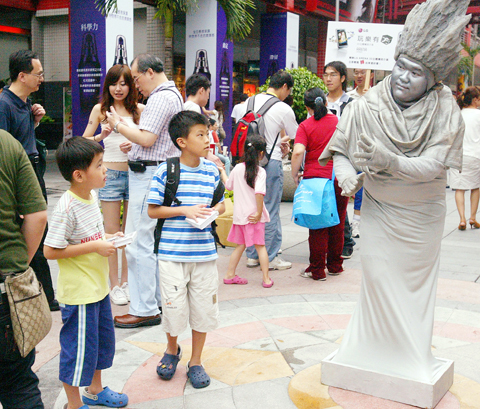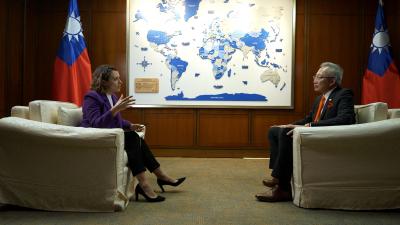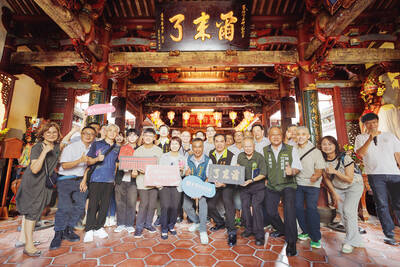Are these motionless human statues real or fake? That’s the question that often crosses the minds of pedestrians passing by Vieshow Cinema Square in Taipei’s Xinyi District (信義).
Their doubts are quickly answered if they toss a coin or bank note in the direction of these statuesque figures, who suddenly spring to life and do a little dance or gesture playfully.
Visually stunning, these mime artists who pose as statues and react to audiences to create moments of comedy, drama or shock have become a special feature of the Taipei street scene, even if Taiwan has yet to embrace the art.

PHOTO: CNA
The fledgling profession got its start in Taiwan about five years ago when Chang Wang (張忘), founder of Headspring Theatre, persuaded Taipei City and the Vieshow management to allow buskers to perform at Vieshow Square on holidays for free.
Since then, Chang, an interdisciplinary artist who works in a variety of media, has created an ensemble of 50 characters called “Meander,” drawing inspiration from nature and the extraterrestrial world in designing roles, styles and costumes for the group’s characters.
Since 2006, flamboyantly and sometimes grotesquely dressed performance artists from Headstring Theatre have “meandered” around Vieshow Cinema Square adding new color and fanfare to local street life.
Many of those characters have fans who visit the Xinyi area on weekends or holidays to interact with their idols. Riding a wave of street fame, Chang’s troupe has received a stream of invitations for private engagements or public performances at home and abroad. Nevertheless, Chang still feels frustrated and worried about the group’s future.
The popularity of street shows measures how cosmopolitan a city is, he says. But local authorities, and at times audiences, seem less receptive to the concept than in other countries.
Chang says when he performed in Europe, he often met police officers who guided street performers to areas where they could perform legally. In La Rambla in the Spanish city of Barcelona, city authorities demarcated spaces for different types of buskers to perform separately and avoid overlapping and disturbing each others’ performances, he says.
By comparison, Vieshow Square and the adjoining walkway are overcrowded and chaotic.
Singers often croon loudly beside the silent and motionless living statues, and retail stalls are sometimes erected in the square to sell farm produce, turning the location into a traditional marketplace or night market.
“We hope the government can demarcate a clear space for street performances and develop the Xinyi shopping district into a special hub for the trade,” Chang said.
If Taipei is not as welcoming as Chang would like, the environment is even worse outside the nation’s capital. The troupe tried its luck at Green Garden Boulevard in Taichung City for a year, but had to quit because of the minimal financial rewards.
That’s unfortunate, Chang says, because street performance, more than any other art form, spreads the seeds of art through its spontaneity, proximity to the audience and low threshold for new entrants, but it also depends on the generosity of viewers.
Members of Chang’s troupe come from a myriad of social classes and businesses, and some are motivated by the need to make money.
“I don’t think it’s bad to have such a motive. On the contrary, I always remind them that as a human sculpture, cash donations are the key to their acting or movements,” Chang said.
He said that Taiwan needs to embrace the principle that people should pay for art or performances rather than always expecting free art.
Chang’s Meander ensemble survives through earnings from private engagements and indoor theater performances. The job can be grueling, he says, and troupe members must practice taichi or shadow boxing and yoga, from which they can acquire flexibility and stamina. They also meditate and visualize themselves as a tree or a stone to obtain inner tranquility, forgetting themselves, he said.
“Through rigorous training, troupe members who originally could only stand still for 10 minutes can now hold on for more than an hour without getting tired,” Chang said.
Wang Chien-wen, the troupe’s “Moon” god, acknowledged that performing as a living statue is a tough job. “If your goal is just to make money, you won’t be around for long.”
But Wang said she enjoys the profession.
“When I performed in Barcelona, I met a Hong Kong traveler who said ‘I’ve seen you in Taipei.’ When I returned to Taiwan, a French tourist told me ‘you’re the one who played this role in the streets of Avignon,’” Wang said.
“It is this kind of borderless love for the arts that has given me the greatest gratification and enjoyment,” Wang said.
In her view, creativity is critical if Taiwan really wants to develop tourism.
“Street performance has become a creative industry in Europe, but when will our dream of having a La Rambla in Taiwan be realized?” she said.
Vanessa Huang, the troupe’s manager, believes that the art form is catching on with younger fans, creating a ray of hope for the future.
Many children like to visit the square to interact with the living statues, Huang said. The challenge for the troupe now is how to create the same cosmopolitan atmosphere in Taiwan that it has experienced while performing overseas, she said.

“China is preparing to invade Taiwan,” Deputy Minister of Foreign Affairs Francois Wu (吳志中) said in an exclusive interview with British media channel Sky News for a special report titled, “Is Taiwan ready for a Chinese invasion?” the Ministry of Foreign Affairs said today in a statement. The 25-minute-long special report by Helen Ann-Smith released yesterday saw Sky News travel to Penghu, Taoyuan and Taipei to discuss the possibility of a Chinese invasion and how Taiwan is preparing for an attack. The film observed emergency response drills, interviewed baseball fans at the Taipei Dome on their views of US President

The Central Weather Administration (CWA) today issued a "tsunami watch" alert after a magnitude 8.7 earthquake struck off the Kamchatka Peninsula in northeastern Russia earlier in the morning. The quake struck off the east coast of the Kamchatka Peninsula at 7:25am (Taiwan time) at a depth of about 19km, the CWA said, citing figures from the Pacific Tsunami Warning Center. The CWA's Seismological Center said preliminary assessments indicate that a tsunami could reach Taiwan's coastal areas by 1:18pm today. The CWA urged residents along the coast to stay alert and take necessary precautions as waves as high as 1m could hit the southeastern

The National Museum of Taiwan Literature is next month to hold an exhibition in Osaka, Japan, showcasing the rich and unique history of Taiwanese folklore and literature. The exhibition, which is to run from Aug. 10 to Aug. 20 at the city’s Central Public Hall, is part of the “We Taiwan” at Expo 2025 series, highlighting Taiwan’s cultural ties with the international community, National Museum of Taiwan Literature director Chen Ying-fang (陳瑩芳) said. Folklore and literature, among Taiwan’s richest cultural heritages, naturally deserve a central place in the global dialogue, Chen said. Taiwan’s folklore would be immediately apparent at the entrance of the

ECONOMIC BENEFITS: The imports from Belize would replace those from Honduras, whose shrimp exports have dropped 67 percent since cutting ties in 2023 Maintaining ties with Taiwan has economic benefits, Ministry of Foreign Affairs officials said yesterday, citing the approval of frozen whiteleg shrimp imports from Belize by the Food and Drug Administration (FDA) as an example. The FDA on Wednesday approved the tariff-free imports from Belize after the whiteleg shrimp passed the Systematic Inspection of Imported Food, which would continue to boost mutual trade, the ministry said. Taiwan’s annual consumption of whiteleg shrimps stands at 30,000 tonnes, far exceeding domestic production, the ministry said. Taiwan used to fill the gap by importing shrimps from Honduras, but purchases slumped after Tegucigalpa severed diplomatic ties with Taiwan